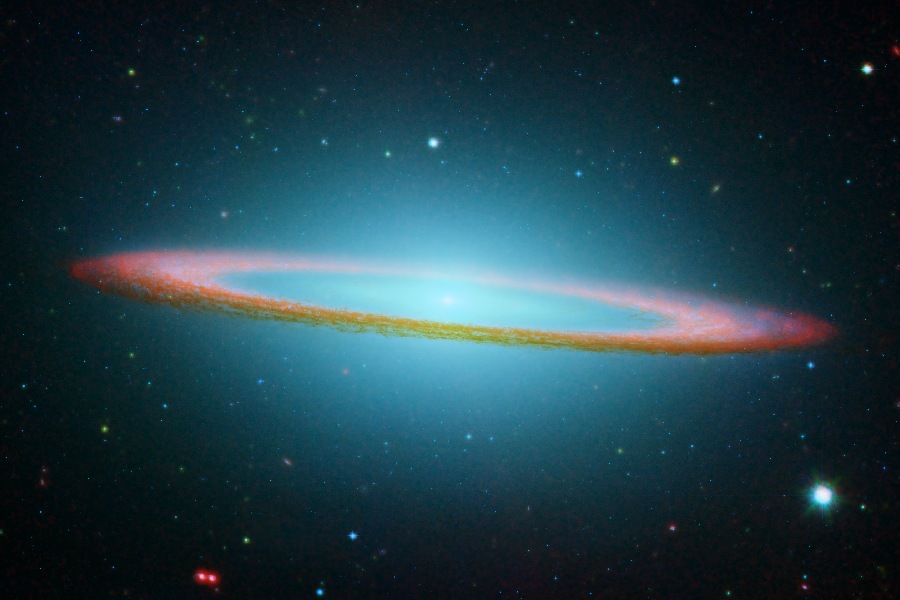Tilting your head back on a clear, dark night, have you spotted the trademark rimmed hat shape of the stunning Sombrero Galaxy? This storied spiral galaxy captivates astrophotographers and scientists alike with its dazzling dust lanes and bulbous central bulge. But just how far away is this ethereal island universe from our earthly vantage point? Understanding the Sombrero Galaxy distance from Earth allows us to appreciate the immense spans across which galaxies’ light travels to reach telescopes.
Determining accurate galaxy distance measurements enables key astrophysical calculations underpinning discoveries from cosmic expansion rates to the ages of stellar populations. Join us on a journey spanning the unfathomable gulf between Earth and the spectacular Sombrero Galaxy.

Sombrero Galaxy Distance From Earth
The Sombrero Galaxy, also known as Messier 104 (M104) or NGC 4594, resides approximately 31.1 million light-years away from our home galaxy, the Milky Way. This staggering distance underscores the vastness of the Universe and the immense scales we grapple with in understanding our place within it.
Interestingly, the Sombrero Galaxy itself is not alone; it belongs to a small group of galaxies known as the Virgo II Groups, embedded within the larger Virgo Supercluster. This supercluster contains thousands of galaxies, offering a glimpse into the large-scale structures that shape the universe.
Early Distance Estimates
The quest to measure the distance to the Sombrero Galaxy, like many other celestial objects, has a rich history.
Early attempts relied on techniques like stellar parallax, which measures the subtle shift in a star’s position relative to a background of distant stars as the Earth orbits the Sun. However, this method proved inadequate for such immense distances, offering little more than a rough estimate.
Modern Distance Measurement Techniques
Parallax method
While limited to objects beyond our immediate stellar neighborhood, advancements in technology have allowed scientists to utilize more distant objects like quasars for parallax measurements, providing a more accurate estimate of the Sombrero Galaxy’s distance.
Standard candles
These astronomical objects serve as cosmic measuring sticks with known intrinsic luminosities. By comparing a galaxy’s apparent brightness with its known intrinsic brightness, scientists can estimate its distance. Scientists can estimate the distance of Sombrero Galaxy from the Earth with the help of:
Cepheid variable stars
These pulsating stars exhibit a relationship between their pulsation period and intrinsic luminosity. By measuring the period of Cepheid variables within the Sombrero Galaxy, astronomers can estimate its distance.
Type Ia supernovae
These exploding stars exhibit consistent peak brightness, making them powerful distance indicators. Observing and analyzing Type Ia supernovae within the Sombrero Galaxy contributes to a more accurate estimation of its distance.
Redshift and Hubble’s Law
This technique measures the shift in the wavelength of light emitted from distant objects, known as redshift. Hubble’s Law tells us that the farther away a galaxy is, the greater its redshift. By analyzing the redshift of the Sombrero Galaxy, scientists can estimate its distance.
Modern astronomy employs cutting-edge technology and a combination of these techniques, along with powerful telescopes and observatories, to refine our understanding of the Sombrero Galaxy’s distance and the vastness of our cosmic neighborhood.
Conclusion
The journey to unveil the Sombrero Galaxy distance from Earth reflects humanity’s ongoing pursuit of knowledge and exploration within the universe. From the limitations of early methods to the sophisticated techniques employed today, our understanding of galactic distances continues to evolve.
As technology and our knowledge of the universe advance, we can expect even more precise measurements, unveiling further insights into the Sombrero Galaxy’s position within the grand cosmic dance.
